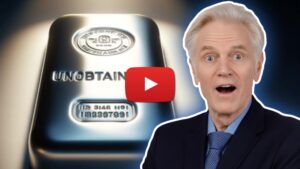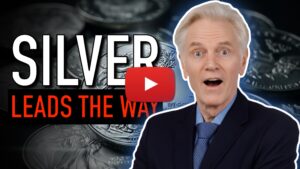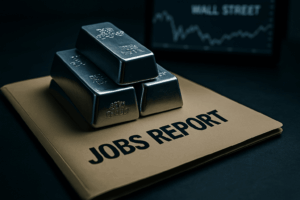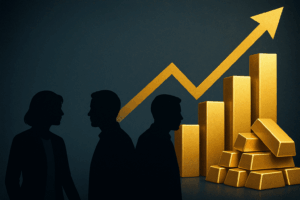Mike Maloney & Alan Hibbard report from the New Orleans Investment Conference
A Different Kind of Energy in New Orleans
At this year’s New Orleans Investment Conference, something felt different. The crowd wasn’t talking about chasing returns or riding the next wave of speculative mania — they were talking about protection.
GoldSilver’s Mike Maloney and Alan Hibbard took the pulse of the event, and what they found was a blend of optimism, caution, and conviction. Investors here aren’t waiting for the headlines — they’re positioning before the next shock hits.
Michael Burry Is Shorting the AI Boom
You remember Michael Burry — the investor who famously shorted the housing market before the 2008 crash.
He’s back in the headlines, this time betting against AI heavyweights like Nvidia and Palantir, calling the tech surge a “bubble.”
As Mike put it, “He’s going short the AI bubble… and he says it is a bubble.”
Burry might not be right tomorrow, but he’s usually early, not wrong. His move has many seasoned investors asking a familiar question: What happens when optimism runs out of steam?
That question — and its potential impact on the broader economy — is why so many are turning back to tangible value: real assets like gold and silver.
Auto Repossessions Spike to 2009 Levels
Behind the market’s glossy AI headlines lies a growing crack in the foundation.
Auto repossessions have quietly climbed to their highest levels since the Global Financial Crisis.
To Mike and Alan, that’s not a coincidence — it’s a signal.
When households start missing payments on something as essential as a car, it’s a sign of deeper financial stress. Rising defaults often appear before broader credit problems, and they rarely stay isolated.
“Stuff is really happening,” Mike said — and for investors paying attention, that’s the kind of data point that can’t be ignored.
Central Banks Have Put a Floor Under Gold and Silver
Even amid short-term pullbacks, the long-term story remains firm.
As Mike explained, “Central banks are putting a floor under gold and silver prices.”
They’ve been quietly but consistently adding to their reserves, diversifying away from currencies that can be printed at will.
That steady demand — from China, India, Turkey, and others — has fundamentally changed the market dynamic. Gold and silver aren’t just investor hedges anymore; they’re strategic reserves for entire nations.
That means even if prices fluctuate, the downside risk is limited. The world’s largest financial players are literally underpinning the market.
This Isn’t the Top — It’s Just the Smart Money Arriving Early
Mike wrapped up the conversation with a simple observation:
“If this were the top, this conference would be five or ten times the size it is now.”
That tells you everything. The investors filling the GoldSilver booth weren’t chasing hype — they were ahead of the curve. Confident, informed, and focused on preservation over speculation.
As Alan put it, “There’s a ton of great energy here. People are excited about gold and silver and what’s happening in the economy.”
In other words: this isn’t fear — it’s foresight.
Watch the Full Conversation from New Orleans
See the full discussion with Mike and Alan — including why they believe central banks have put a permanent floor under gold and silver prices, and what that means for your portfolio.
👉 Watch the full video now on YouTube »
People Also Ask
What does it mean that central banks have “put a floor under gold prices”?
Central banks around the world — including China, India, and Turkey — have been steadily buying gold to reduce reliance on the U.S. dollar. Their ongoing demand creates a natural “floor,” or support level, that limits how far gold prices can fall. Watch Mike Maloney and Alan Hibbard explain it in full on GoldSilver’s YouTube Channel.
Why is Michael Burry shorting AI stocks like Nvidia and Palantir?
Michael Burry, famous for predicting the 2008 financial crisis, believes the current AI stock boom shows bubble-like characteristics — high valuations and speculative behavior. His move to short these stocks signals growing concern about tech overvaluation.
Are auto repossessions really back to 2009 levels?
Yes. U.S. auto repossessions have climbed to their highest levels since the Global Financial Crisis, signaling that household debt stress is rising. Mike Maloney notes this as a warning sign for the broader economy — a potential early indicator of market strain.
Why are investors turning to gold and silver in 2025?
With growing uncertainty around inflation, debt, and political instability, investors are seeking safety in tangible assets. Gold and silver offer protection from currency debasement and remain time-tested stores of value — especially as central banks accumulate them.
Is this the top of the gold and silver market?
According to Mike Maloney, not even close. If gold were at its peak, investor conferences would be overflowing — instead, participation remains modest, suggesting the bull market is still early.
Get Gold & Silver Insights Direct to Your Inbox
Join thousands of smart investors who receive expert analysis, market updates, and exclusive deals every week.








